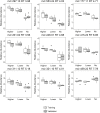The Use of Metabolomics to Identify Biological Signatures of Manganese Exposure
- PMID: 28355443
- PMCID: PMC6075188
- DOI: 10.1093/annweh/wxw032
The Use of Metabolomics to Identify Biological Signatures of Manganese Exposure
Erratum in
-
Corrigendum to: The Use of Metabolomics to Identify Biological Signatures of Manganese Exposure.Ann Work Expo Health. 2020 Nov 16;64(9):1039-1040. doi: 10.1093/annweh/wxz034. Ann Work Expo Health. 2020. PMID: 31259379 Free PMC article. No abstract available.
Abstract
Objectives: Manganese (Mn) is a known neurotoxicant, and given its health effects and ubiquitous nature in metal-working settings, identification of a valid and reproducible biomarker of Mn exposure is of interest. Here, global metabolomics is utilized to determine metabolites that differ between groups defined by Mn exposure status, with the goal being to help inform a potential metabolite biomarker of Mn exposure.
Methods: Mn exposed subjects were recruited from a Mn steel foundry and Mn unexposed subjects were recruited from crane operators at a metal recycling facility. Over the course of a work day, each subject wore a personal inhalable dust sampler (IOM), and provided an end of shift urine sample that underwent global metabolomics profiling. Both exposed and unexposed subjects were divided into a training set and demographically similar validation set. Using a two-sided adjusted t-test, relative abundances of all metabolites found were compared between Mn exposed and unexposed training sets, and those with a false discovery rates (FDR) <0.1 were further tested in the validation sets.
Results: Fifteen ions were found to be significantly different (FDR < 0.1) between the exposed and unexposed training sets, and nine of these ions remained significantly different between the exposed and unexposed validation set as well. When further dividing exposure status into 'lower exposure' and 'higher exposure', several of these nine ions exhibited an apparent exposure-response relationship.
Conclusions: This is the first time that metabolomics has been used to distinguish between Mn exposure status in an occupational cohort, though additional work should be done to replicate these findings with a larger cohort. With metabolite identification by name, empirical formula, or pathway, a better understanding of the relationship between Mn exposure and neurotoxic effects could be elucidated, and a potential metabolite biomarker of Mn exposure could be determined.
Keywords: biomarkers of exposure; exposome; exposure assessment; manganese; metabolomics.
© The Author 2017. Published by Oxford University Press on behalf of the British Occupational Hygiene Society.
Figures


Comment in
-
The Use of High-Resolution Metabolomics in Occupational Exposure and Health Research.Ann Work Expo Health. 2017 May 1;61(4):395-397. doi: 10.1093/annweh/wxx016. Ann Work Expo Health. 2017. PMID: 28403429 No abstract available.
References
-
- Apostoli P, Lucchini R, Alessio L. (2000) Are current biomarkers suitable for the assessment of manganese exposure in individual workers? Am J Ind Med; 37: 283–90. - PubMed
-
- Astle J, Ferguson JT, German JB, et al. (2007) Characterization of proteomic and metabolomic responses to dietary factors and supplements. J Nutr; 137: 2787–93. - PubMed
MeSH terms
Substances
Grants and funding
LinkOut - more resources
Full Text Sources
Other Literature Sources
Medical
